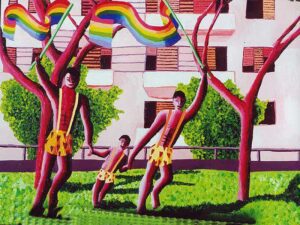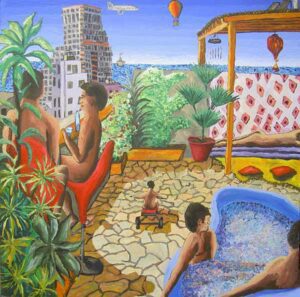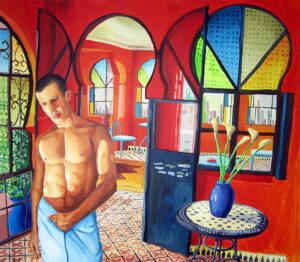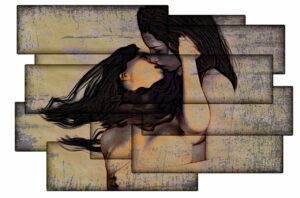Queer art is a vibrant and defiant expression of the LGBTQ+ community’s perspectives, challenging traditional norms and celebrating diverse identities.
It’s not just a style or a genre; it’s a powerful form of cultural commentary that pushes boundaries and sparks conversation.
In this article, we’ll explore the rich tapestry of queer art, its historical context, and its impact on society.
We’re diving into an art form that’s as varied and dynamic as the community it represents, so get ready to discover the beauty and complexity of queer creativity.
Historical Context Of Queer Art
The emergence of queer art is intricately tied to the LGBTQ+ community’s struggle for recognition and acceptance.
Throughout history, artists have used their works as a form of protest and commentary on societal norms.
In ancient times, there were expressions of queerness, albeit not labeled as such today, in texts, art, and philosophy.
But, the modern
During the 20th century, many queer artists were at the forefront of avant-garde movements.
They subverted the mainstream by creating art that was unapologetically queer.
Notable movements that included queer perspectives encompass –
- The Harlem Renaissance,
- Dadaism,
- Surrealism,
- Pop art.
Even though societal pressures, these artists persevered, crafting works that communicated the multiplicities of queer experience.
also, the Stonewall Riots of 1969 marked a turning point, igniting a more visible and vocal public discourse around LGBTQ+ rights and by extension, queer artistry.
As queer art gained traction in the latter part of the 20th century, several artists and their works became emblematic of the LGBTQ+ experience.
Figures like Andy Warhol, with works like Silver Car Crash (Double Disaster) and films like Chelsea Girls, played with notions of sexuality and identity.
Meanwhile, photographers like Robert Mapplethorpe challenged the public with candid and at times controversial depictions of the human body and queer sexuality.
The AIDS crisis of the 1980s and 1990s further amplified the urgency of queer art.
Artists like Keith Haring used their art to bring attention to the epidemic and advocate for compassion and change.
The disease’s impact on the community left an indelible mark on the art world, birthing works that were both a tribute to those lost and a call to action for those who remained.
Films, too, played a pivotal role in documenting and expressing queer narratives.
Directors like Pedro Almodóvar and Gus Van Sant brought queer stories to mainstream audiences with films like All About My Mother and My Own Private Idaho.
These films, and many others, provided a vital platform for sharing the intricacies of queer life with a broader audience.
Defying Traditional Norms: The Power Of Queer Art
The influence of queer art on the cultural landscape is as transformative as it is profound.
By stepping outside the constraints of conventional aesthetics, queer artists have redefined what it means to create art that is both personal and political.

This defiance has a dual function – it asserts the existence and value of queer experiences while simultaneously critiquing a society often unprepared for such candidness.
One of the key strengths of queer art is its versatility in communicating nuanced queer narratives.
Whether through film, painting, or performance art, these expressions share an authenticity that resonates with audiences far and wide.
Films such as Paris Is Burning and Call Me by Your Name, though different in style and era, both navigate the complexities of queer identity and community with a grace that invites empathy and understanding.
Queer art doesn’t just reflect the realities of LGBTQ+ lives; it actively shapes cultural discourse around gender and sexuality.
Consider the following impacts:
- Visibility – Queer art platforms marginalized voices, making the invisible undeniably present.
- Dialogue – It ignites conversations, challenging people to think beyond binary constructs of identity.
- Empowerment – By representing diverse queer experiences, it empowers individuals to embrace their authenticity.
In the realm of filmmaking, queer cinema has pushed boundaries, affirming that the medium is a powerful arsenal against silence and invisibility.
Directors like Pedro Almodóvar and Dee Rees showcase the multifaceted stories of queer individuals, compelling audiences to witness narratives that mainstream cinema often overlooks.
Our commitment to these stories is not just about representation; it’s about creating an inclusive film culture that honors all facets of human experience.
As we continue to explore the rich tapestry of queer art, we recognize its indispensable role in societal progress.
We witness the ongoing conversation between art and audience, a testament to the indomitable spirit of queer creativity.
And through our lenses, we document, celebrate, and amplify the colors of the full human spectrum, ensuring that these vital stories find their place on the silver screen and beyond.
Exploring Diverse Identities Through Queer Art
Queer art isn’t just a vibrant facet of contemporary culture; it’s a profound commentary on identity and existence.
Within its rich spectrum lies the essence of countering erasure and celebrating diversity.
By dissecting traditional gender roles and sexual norms, artists like Felix Gonzalez-Torres and Catherine Opie introduce audiences to the complexities of queer experiences.
Their visuals create a narrative mosaic that transcends singular perspective.
Films have become an integral medium for queer expression, with directors like Pedro Almodóvar crafting stories that resonate on a deeply personal level.
Works like All About My Mother and Pain and Glory navigate identity with nuance and empathy.

Queer cinema is instrumental in shifting public perception –
- It facilitates a dialogue on the intersections of sexuality, gender, and societal expectations.
- It showcases a kaleidoscope of experiences, unearthing the multiplicities within queer communities.
- It plays a critical role in empowering queer individuals by validating their identities onscreen.
The fusion of visual art with narrative filmography bridges lived experiences with artistic representation.
The multifaceted nature of queer art invites viewers to consider the textured layers of human identity.
Through the emotive lens of queer filmmakers, we gain a visceral understanding of the lives they portray.
An ever-expanding genre, queer cinema mirrors the transformation and resilience that are hallmarks of the LGBTQ+ movement.
By engaging with queer art, we not only appreciate its aesthetic but also grasp a broader insight into the queer ethos.
These artworks and films ignite crucial conversations, pushing forward the boundaries of traditional narrative and visual paradigms.
The Impact Of Queer Art On Society
As we examine the cultural landscape shaped by queer artists, it’s clear that their contributions have extended far beyond the traditional confines of galleries and theatres.
The impact of queer art finds its resonance in the way it has:
- Propelled conversations around LGBTQ+ rights,
- Questioned societal norms and gender constructs,
- Fostered a community for marginalized voices.
By threading the fabric of society with bold and unapologetic expressions of identity, queer art has laid the groundwork for more inclusive dialogues.
Films like Paris Is Burning and artworks by Felix Gonzalez-Torres have brought about an understanding of the struggles, triumphs, and everyday realities of queer lives.
These pieces have not only educated broader audiences but have also given rise to new forms of advocacy and representation, catalyzing political and social change.
It’s imperative to recognize that the narratives depicted through queer cinema and art are potent tools for change.
History has shown us that movements are not only fueled by actions but also by the symbols and stories that echo the collective sentiment.
Queer art, in its essence, transcends aesthetic value – it’s a vehicle for activism and social commentary.
Through films, visual arts, and performance, the queer community has effectively utilized art as a means to:
- Challenge oppressive systems,
- Celebrate queer existence,
- Promote solidarity and understanding.
Our understanding of the myriad of human experiences is enriched by the diverse identities and stories captured by queer artists.
As storytellers and visionaries, their work continues to shape public perception and advocate for a society that values and recognizes LGBTQ+ lives.
As queer art garners mainstream attention, its influence permeates every level of society.
We’ve witnessed the impact not just in the arts but also in fashion, media, and public policy.
The narratives and aesthetics rooted in queer creativity inspire broader cultural shifts, signaling a future where the full spectrum of human expression is celebrated.
Celebrating Queer Creativity: A Look At Notable Queer Artists
In the vast tapestry of queer art, certain names stand out for their groundbreaking work and influence.
It’s these artists who have paved the way for future generations, allowing us to witness the world through a profoundly unique lens.
Their contributions have not only shaped the art world but have also played a critical role in societal change.
- Frida Kahlo – Her self-portraits are a bold, raw expression of identity that transcends conventional barriers of gender and sexuality.
- Jean-Michel Basquiat – His graffiti-inspired works confront the intersections of race, sexuality, and society with a poignancy that continues to resonate.
Echoing the defiance and resilience of the queer community, each artist brings their personal narrative to the forefront.

For instance, Kahlo’s The Two Fridas and Basquiat’s Untitled (Boxer) reflect personal and societal struggles in a manner that is both striking and enlightening.
Filmmakers within the queer community have utilized the medium to explore and express queer identities in ways that challenge and enthrall audiences.
Directors like Pedro Almodóvar and filmmakers such as Marlon Riggs have been instrumental in crafting narratives that highlight queer experiences.
- Pedro Almodóvar – His films often feature complex, multifaceted queer characters and have garnered international acclaim.
- Marlon Riggs – His documentary Tongues Untied gave voice to black gay men, combining poetry and personal narratives to weave a poignant story of identity and resilience.
Their visual storytelling magnifies the intricate textures of queer life, inviting viewers to understand and empathize with perspectives outside their own.
Both Almodóvar’s vibrant, passionate storytelling and Riggs’ courageous exploration of race and sexuality exemplify the power of cinema to humanize and validate the queer experience.
What Is Queer Art – Wrap Up
We’ve explored the rich tapestry of queer art and its undeniable influence on culture and society.
This art form has been pivotal in shaping dialogues and providing a platform for the LGBTQ+ community.
Through the works of trailblazing artists and filmmakers queer art continues to challenge the status quo and offer a vibrant reflection of diverse experiences.
It’s a celebration of identity and a testament to the resilience and creativity of the queer community.
As we witness the ongoing evolution of queer art we’re reminded of its power to inspire change and its crucial role in the fight for equality and representation.
Queer art isn’t just a category—it’s a dynamic force that transcends boundaries and empowers voices long silenced.

Here’s to the artists who dare to dream and the art that promises a more inclusive and expressive future for us all.
Frequently Asked Questions
What Is Queer Art And Why Is It Significant?
Queer art is a diverse range of artistic expression that challenges mainstream ideas about gender and sexuality, often serving as protest and commentary on societal norms.
Its significance lies in its power to question traditional norms, increase LGBTQ+ visibility, and act as a form of activism and social commentary.
How Did Queer Art Emerge And What Are Its Historical Influences?
Queer art emerged as a form of protest, particularly during avant-garde movements such as the Harlem Renaissance, Dadaism, Surrealism, and Pop Art.
These movements provided a platform for queer perspectives to be incorporated into the mainstream art narrative.
Who Are Some Key Artists In The History Of Queer Art?
Important figures in queer art include Andy Warhol, Robert Mapplethorpe, Keith Haring, Frida Kahlo, and Jean-Michel Basquiat, whose works have become emblematic of the LGBTQ+ experience and contributed to societal change.
How Did The Aids Crisis Impact Queer Art?
The AIDS crisis in the 1980s and 1990s amplified the urgency of queer art, motivating artists like Keith Haring to use their art to bring attention to the epidemic and the struggles of the LGBTQ+ community.
What Role Has Queer Cinema Played In Lgbtq+ Representation?
Queer cinema has been instrumental in pushing boundaries and fostering an inclusive film culture by documenting and expressing queer narratives, thus shifting public perception and empowering queer individuals.
How Does Queer Art Influence Fashion, Media, And Public Policy?
Queer art has significantly influenced these fields by propelling conversations around LGBTQ+ rights, challenging gender constructs, and fostering communities for marginalized voices, leading to broader cultural shifts and inclusion in various aspects of society.
What Future Impact Might Queer Art Have On Society?
Queer art is expected to continue inspiring cultural shifts and celebrate the full spectrum of human expression.
It serves as a powerful tool for LGBTQ+ activism and is likely to shape public perception and policy in more inclusive and diverse ways.


